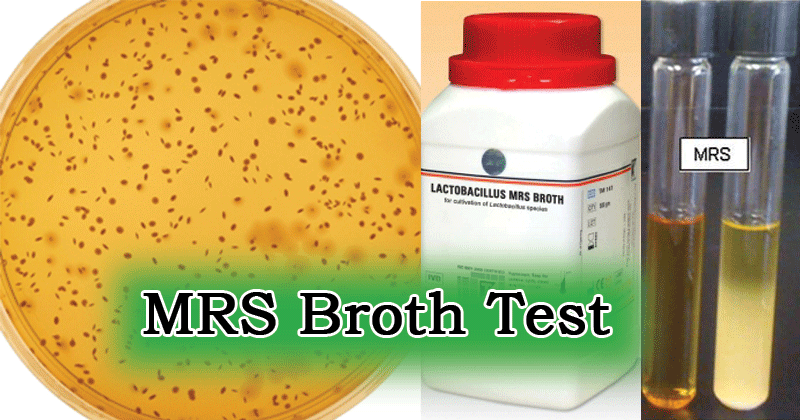Interesting Science Videos
Objectives of MRS Broth Test
- It is used for the cultivation and enumeration of lactobacilli in a laboratory setting
- To determine the ability of organism to form gas during glucose fermentation
Principle of MRS Broth Test
MRS Broth is an improved medium for lactobacilli, it supports good growth and is particularly useful for a number of fastidious strains which grow poorly on other general media. It was originally developed in 1960 by De Man, Rogosa & Sharpe, the medium can be used for confirmatory tests on organisms isolated on MRS Agar. It contains enzymatic digest of animal tissue, beef extract, and yeast extract, which are the carbon, nitrogen, and vitamin sources used to satisfy general growth requirements in MRS Broth medium. Dextrose is the fermentable carbohydrate incorporated in the medium. Sodium Acetate in broth is an inhibitory agent. Sodium Acetate and Ammonium Citrate act as energy source as well as selective agents to prevent overgrowth by contaminating organisms. Potassium Phosphate is the buffering agent. Magnesium Sulfate and Manganese Sulfate provide cations used in metabolism. Polysorbate 80 is a surfactant, facilitating uptake of nutrients by lactobacilli. The growth of the organism is indicated by the turbidity on the medium and production of gas during the sugar fermentation is indicated by bubbles on the Durham tube in the broth medium.
Media Used in MRS Broth Test
| Dextrose | 20.0gm |
| Peptic Digest of Animal Tissue | 10.0gm |
| Beef Extract | 10.0gm |
| Yeast Extract | 5.0gm |
| Sodium Acetate | 5.0gm |
| Disodium Phosphate | 2.0gm |
| Ammonium Citrate | 2.0gm |
| Polysorbate 80 | 1.0gm |
| Magnesium Sulfate | 0.1gm |
| Manganese Sulfate | 0.05gm |
Final pH 6.5 +/- 0.3 at 25ºC.
Procedure of MRS Broth Test
- Inoculate MRS broth with an 18 to 24 hour culture of organism .
- Incubate the tube for 24 to 48 hours at 35°-37°C in ambient air.
- Examine the test tube for turbidity and gas production.
Result Interpretation of MRS Broth Test

Positive test: Lactobacillus spp.—Growth (turbidity in the medium), no gas production
Positive test: Leuconostoc sp.—Growth, gas production indicated by a bubble in the Durham tube
Negative test: No turbidity (no growth), no gas production
Limitations of MRS Broth Test
- Due to varying nutritional requirements, some strains may be encountered that grow poorly or fail to grow on this medium.
- Organisms other than lactobacilli may grow in this medium. Isolates must be confirmed as lactobacilli by appropriate biochemical testing.
Quality Controls of MRS Broth Test
Lactobacillus fermentum (ATCC9338) – Growth, gas in durham tube
Lactobacillus acidophilus (ATCC4356) – Growth, no gas in durham tube
Pseudomonas aeruginosa (ATCC 27853) – no growth
References
- Tille P.M. 2014. Bailey and Scott’s diagnostic microbiology. Thirteen edition. Mosby, Inc., an affiliate of Elsevier Inc. 3251 Riverport Lane. St. Louis. Missouri 63043
- Merck Microbiology Manual. 12th Edition. MRS broth.
- Scharlau lab. MRS Broth Art. No. 02-135. http://www.scharlabmagyarorszag.hu/katalogus/02-135_TDS_EN.pdf
- Acumedia A subsidiary of Neogen Corporation. Lactobacilli MRS Broth (7406) http://foodsafety.neogen.com/pdf/acumedia_pi/7406_pi.pdf
